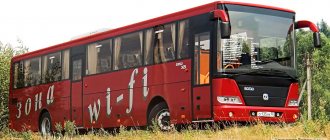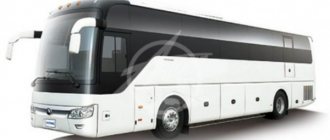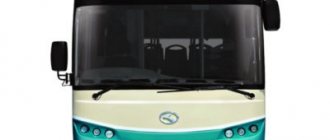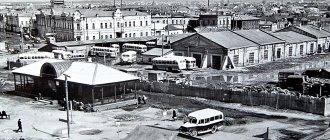City trains-2: the carrier's view
Andrey Filippov, photo by the author
A test drive of 15-meter city buses in operation in Moscow bus depots caused a mixed reaction from bus manufacturers. The main complaint is that the test was lobbied by MAZ. Considering that the task was to impartially evaluate buses from the point of view of passengers, this reaction left me bewildered. And although not everyone perceived the article as custom-made (representatives of Ukravtobusprom, for example, assessed this approach as quite professional), in the second part, dedicated to the technical content of the 15-meter machines, it was decided to talk about the opinion of those who directly work on these machines...
At the head of the salon
The topic of our story is the 15-meter city buses CityRhythm-15, GolAZ-6228 and MAZ-107-065. The cabins of this trio, in accordance with the Moscow characteristics of transportation among drivers, are called small, that is, they do not have a separate exit to the street. Leaving aside the “like-dislike” factor, let’s evaluate what the “ship’s commander” sees from his seat when it is necessary to turn left or right from a minor road. What a pedestrian there is - you might not see the Kirovets truck crane! And this is with complete transparency of the glass and the absence of passengers crowding on the front platform. And we say – safety comes first!
There are also questions about the mirror system. If interior ones are convenient in all cars, then with external ones it is more difficult. When using the forward left GolAZ lens, you need to turn your head less, but in order to wipe it from dirt, you will have to go outside. In Volzhanin and MAZ, all you need to do is open the window, and on the 107th, the window in the mirror area is equipped with additional heating. Otherwise, there are no complaints about visibility, but personally I liked the GolAZ more according to the principle “I sit high - I can look far.”
The layout of the cabins is different, and it is quite difficult to talk about the advantages of one or another layout. In all buses you can find a place for storing “useful little things”, and in “CityRhythm-15” a niche is used for this purpose, designed for viewing through an additional window in the right corner. Since it turned out to be impossible to use in practice, drivers found a more rational use of this design. The GolAZ cabin seems to be the smallest, but at the same time everything is at hand - there was even a place on the panel for a radio. But the space above the head is used rather stupidly, there is only a lighting lamp.
In the MAZ-107 there is a lockable compartment for things above your head and niches for a radio and voice informer, which you can use without getting up from your seat. You can hang your sheepskin coat loosely behind your back. Do you think this is the leader? Whatever the case. On the flattened instrument panel there was no room for recesses, cup holders, or deflectors directing air towards the driver. There’s nowhere to even stick a ticket. So sometimes the feeling of spaciousness turns into a feeling of a bare field...
And one more common drawback - on all these buses, “on-site modifications” were carried out to protect the driver from the sun’s rays. Maybe the designers should still try to come up with a different configuration for the sun shade?
About the manufacturer
The plant was founded in 1993. In the first few years, the company specialized in assembling buses from kits from the Likinsky Bus Plant. In 1995, production of tourist-class equipment began, and a model for intercity travel, 5268, . From 1995 to 1997, work was carried out on the creation and assembly of prototypes of Volzhanin-5270. In 1998, production was certified according to the international quality system ISO 9001, and a certificate was received for the development and production of TUV CERT buses.
In 1999, serial production of buses under the Volzhanin brand began. In 2000, serial production of suburban and intercity models began. In 2003, a 15-meter intercity airliner on a Scania chassis was created (!for the first time in Russia). In 2004, a prototype of a small bus on a TATA chassis, Volzhanin-3290, was created. In 2006, the first completely low-floor bus in the Russian Federation with a body made of aluminum alloy, CityRhythm, was created.
Bus CityRhythm-15. Photo Wikipedia
In 2006, Volzhanin became the first Russian plant to present its bus at the world exhibition of commercial vehicles "IAA" in Hannover, Germany , and in 2007 - at the main world exhibition "Busworld" in the city of Kortrijk (Belgium). Despite the success of the enterprise and its products, in 2007 the production of buses under the Volzhanin brand ceased. At the same time, the company became part of the Volgabus holding.
Iron as it is
The design of 15-meter machines is not very different from shorter ones. The most characteristic detail that allows you to determine the length of the bus is the additional 3rd axle. The Volzhanin and GolAZ have a steerable axle and its rotation angle depends on the direction of the front wheels. MAZ has a self-aligning axle. But the apparent simplicity turns into unnecessary problems. The fact is that to move in reverse, you must first drive a little forward so that the wheels are straight and when you engage reverse gear, the locking pin locks them in this position. Otherwise, the transmission simply does not engage, so transport workers are not very fond of such a system.
The designs of the 2nd drive axis also differ; they are directly dependent on the chosen scheme for changing the floor level. I will not consider them separately, I will only note that the portal bridge used on the Volzhanin is the most expensive.
It is also worthy of attention that the suspension of each bus differs in the placement of air springs, shock absorbers, and the fastening of reaction rods. Even the placement of the anti-roll bars is different. At Volzhanin they are installed on the 1st and 2nd axes. On GolAZ there is no stabilizer on the drive axle, but it is on the 3rd, steerable axle.
The design of the engine compartment also has its own characteristics. The engines of the Volga and Minsk vehicles are shifted to the left. Moreover, the shaft layout made it possible for MAZ to compactly place the radiator next to the engine, and not to pull long hoses and belts to it to drive the cooling fan, as in CityRhythm-15. The central location of the engine in GolAZ is dictated by the use of a ready-made Scania chassis.
Technical characteristics of buses
| "Volzhanin-6270 CityRhythm-15" | GolAZ-6228-010 | MAZ-107-065 | |
| Wheel formula | 6x2x4 | 6x2x4 | 6x2x4 |
| Total weight, kg | 23 800 | 24 000 | 24 500 |
| Curb weight, kg | 15 280 | 14 300 | 14 300 |
| Passenger capacity, persons/including seating | 116/ 34 | 147/ 37 | 145/ 25 |
Permissible load, kg:
| 7000 11 200 6500 | 6500 11 500 6000 | 6500 11 500 6500 |
Engine:
| Deutz BF6M1013FC, turbodiesel I-6 7145 272 at 2520 min-1 1050 at 1400 min-1 | Scania DC 9 03, turbodiesel, I-6 8974 300 at 1900–2000 min-1 1400 at 1100–1300 min-1 | MB OM 906LA, turbodiesel, I-6 6374 279 at 2200 min-1 1100 at 1200–1600 min-1 |
| Transmission | ZF Ecomat 2 plus 6 HP502C, GMP | ZF 5 HP602C, GMP | Voith Diwa D 851.3E, GMP |
| Suspension | Air springs | Air springs | Air springs |
| Brake system | Pneumatic, dual-circuit, with ABS | Pneumatic, dual-circuit, with ABS | Pneumatic, dual-circuit, with ABS |
| Minimum turning radius, m | 12,5 | 12 | 12,5 |
| Fuel tank capacity, l | 250 | 238 | 220 |
Scope of application
Volzhanin-6270 is a high-capacity city bus designed to operate on municipal routes. Considering the design features, the transport can also be used for intercity transportation, as indicated by the low-floor profile and an additional door in the middle.
The idea of creating 15-meter buses has been discussed for a long time. The developers considered the experience of European transport companies that used buses of this length on intercity lines. We are talking about three-axle models NEOPLAN and MERCEDES. Stability of such machines was given by the coordinated position of the bridges during movement. Taking this as a basis, Volga designers developed their own three-axle bus model for urban passenger transportation. The first buses were produced on the SCANIA wheeled chassis, which was later abandoned.
Subjective view of a specialist
After long-term operation of outdated Ikarus buses and the LiAZ-5256, which dates back to the 1980s, the impression of the 15-meter ones is, of course, good. But to find out how good they really are and what shortcomings they have, I talked with the deputy chief engineer of the transport enterprise, Igor Anatolyevich Kolyagin.
A.F.: How comfortable are the cabins?
I.K.: They are quite comfortable. Only in Volzhanin does one feel a sense of discomfort due to the fact that the right corner of the cabin is glass. But this can be quickly resolved by installing curtains.
A.F.: What about visibility?
I.K.: All models have good visibility. In GolAZ, an additional mirror is built into the bracket on the right for monitoring the front wheel and the 1st door - very convenient. In other buses you have to install a similar mirror yourself, but in CityRhythm-15 the right lens, when the driver is in a certain position, glares in the partition or disappears completely behind it.
A.F.: Which bus do drivers like best?
I.K.: In general, all the cars are good. However, in the extremely limited space of the repair zone there are more problems with the MAZ bus; it is less maneuverable.
A.F.: Since we mentioned repair shops, how convenient is it to carry out ETO?
I.K.: There are no complaints about Volzhanin and GolAZ. But to add coolant to the MAZ, you need a ladder. The expansion tank is located on the left in the engine shaft, under the roof itself. And if in the park this is still tolerable, then if there is a coolant leak on the line, the technical assistance takes the ladder with them, and then places it on the roadway. In a crowded city, this is a very dangerous decision.
A.F.: What about major breakdowns and are there any “congenital diseases”?
I.K.: Of course, not without it. The Volzhanin has a very tight layout of the engine compartment, and getting to the pipes and hoses requires a fair amount of flexibility and dexterity. What complicates the task is that the compartment hatches are small and, moreover, are fastened with bolts that constantly break off. The mechanics are very pleased with the mezzanine near the 1st door and the constantly leaking oil seals of the drive axle gearbox.
The GolAZ-6228 uses a fully assembled Scania L94UB 6x2x4 chassis with its own power unit, and the Golitsyn plant is only installing the body. The foreign power unit and gearbox are quite reliable, but they also require maintenance and sometimes repair. Thus, belt tension rollers fail after 150–200 thousand km, and replacing them is expensive. In addition, as it turns out, it is quite difficult to reach individual components (for example, some pipes of the cooling system). If we talk about the body, sometimes the windows come off. Quite often, door mechanisms and their electrical wiring fail. In addition, the control button for the 1st door from the outside is located in the left side hatch - if you want to get inside or close the door, go out onto the road. But it’s definitely encouraging that the complex climate control system is quite reliable and all its breakdowns come down to malfunctions of the control electrovalves in the cooling system.
MAZ has many complaints about the unreliable control system of the 3rd rotary axle. In addition, by analogy with the MAZ-103, after a run of 250–300 thousand km, destruction of the drive axle gearbox is expected.
A.F.: Which bus is more convenient for maintenance and repair?
I.K.: GolAZ and MAZ.
A.F.: If it were possible to switch the fleet to one model, which bus would you personally choose?
I.K.: If we remove “congenital diseases”, then GolAZ. MAZ is in second place, Volzhanin is in third. But this assessment is subjective and contains many factors that can be looked at in different ways. In any case, 15-meter single machines are in no way inferior to articulated ones, and in some respects even surpass them.
Excerpt characterizing Volzhanin-6270
- Prince, I didn’t call you to my place, go, please, go! “He jumped up and opened the door for him. “Go,” he repeated, not believing himself and rejoicing at the expression of embarrassment and fear that appeared on Prince Vasily’s face. - What happened to you? You are sick? - Go! – the trembling voice spoke again. And Prince Vasily had to leave without receiving any explanation. A week later, Pierre, having said goodbye to his new friends, the Freemasons, and leaving them large sums of alms, left for his estates. His new brothers gave him letters to Kyiv and Odessa, to the Freemasons there, and promised to write to him and guide him in his new activities. The affair between Pierre and Dolokhov was hushed up, and, despite the sovereign’s then strictness regarding duels, neither both opponents nor their seconds were harmed. But the story of the duel, confirmed by Pierre’s breakup with his wife, became public in society. Pierre, who was looked upon condescendingly and patronizingly when he was an illegitimate son, who was caressed and glorified when he was the best groom of the Russian Empire, after his marriage, when brides and mothers had nothing to expect from him, lost greatly in the opinion of society, especially that he did not know how and did not want to curry public favor. Now he alone was blamed for what had happened, they said that he was a stupid jealous person, subject to the same fits of bloodthirsty rage as his father. And when, after Pierre’s departure, Helen returned to St. Petersburg, she was not only cordially, but with a touch of respect for her misfortune, received by all her acquaintances. When the conversation turned to her husband, Helen adopted a dignified expression, which she, although not understanding its meaning, with her characteristic tact, adopted for herself. This expression said that she decided to endure her misfortune without complaining, and that her husband was a cross sent to her from God. Prince Vasily expressed his opinion more openly. He shrugged his shoulders when the conversation turned to Pierre, and, pointing to his forehead, said: “Un cerveau fele – je le disais toujours.” [Half-crazy - I always said that.] “I said in advance,” Anna Pavlovna said about Pierre, “I said right then, and before everyone else (she insisted on her primacy), that this is a crazy young man, spoiled by the depraved ideas of the century. I said this back then, when everyone admired him and he had just arrived from abroad, and remember, one evening I thought he was some kind of Marat. How did it end? I didn’t want this wedding then and predicted everything that would happen. Anna Pavlovna continued to host such evenings on her free days as before, and those that she alone had the gift of arranging, evenings at which she gathered, firstly, la creme de la veritable bonne societe, la fine fleur de l' essence intellectuelle de la societe de Petersbourg, [the cream of a truly good society, the color of the intellectual essence of St. Petersburg society,] as Anna Pavlovna herself said. In addition to this refined choice of society, Anna Pavlovna’s evenings were also distinguished by the fact that each time at her evening Anna Pavlovna presented her society with some new, interesting face, and that nowhere, as at these evenings, was the degree of the political thermometer expressed so clearly and firmly, on which the mood of the court legitimist St. Petersburg society stood.
The right to choose
It was not possible to obtain information about the price of Volzhanin directly from the plant. Therefore, we present data from the Internet - 6,527,000 rubles. Not a little, however.
GolAZ-6228 costs much less - 5,900,000 rubles. The warranty and service intervals are almost the same as the Volga car - 1 year and 40,000 km, respectively.
The Belarusian bus is now available only in a post-restyling form for 4,820,000 rubles. The factory warranty will end in 1 year, provided that the service interval of 30 thousand kilometers is observed.
Naturally, when choosing a particular vehicle, each transport worker will have to take into account a huge number of factors: the length of the route, the distance between stops, the presence of normal roads, the possibility of promptly switching rolling stock, its unification, etc., etc. But they are still decisive in This list will include passenger traffic density, profitability of operation and, of course, price. It is these three questions that we tried to answer...
The editors thank the State Unitary Enterprise "Mosgortrans" and the 16th bus depot of Moscow for their assistance in preparing the article
Tales for VIP
To fully characterize these buses, it is worth noting one point that is not directly related to specific modifications, but gives a more complete picture.
Volzhanin “CityRhythm-15” is a follower of the first city 15-meter race “Volzhanin-15M”. It takes into account the shortcomings of the first-born. For now, the car is produced exactly in the form in which it is presented in the article.
GolAZ-6228 is the first and only model of the “city dweller” from Golitsyno. Its modernization is not planned in the near future, and when you order you will receive a bus that is practically no different from the one described.
The tested MAZ-107 is one of the first buses of this model. Last year, a fairly serious modernization of the car was carried out, affecting the appearance, ventilation and heating systems, and interior layout. So if you decide to replenish your fleet with “long-length vehicles” from Minsk, you will get slightly different equipment.










